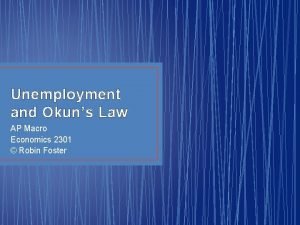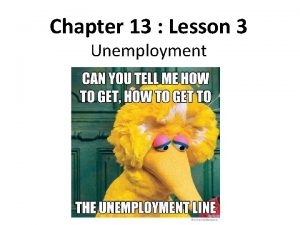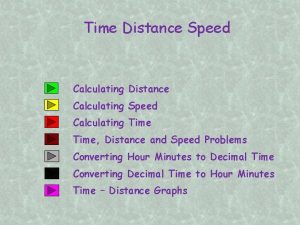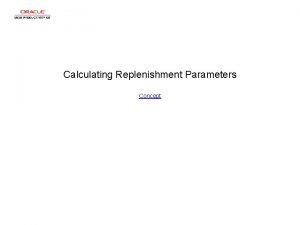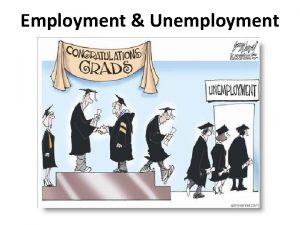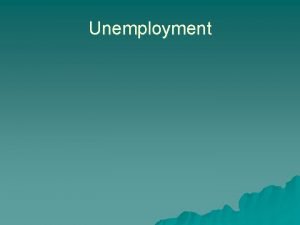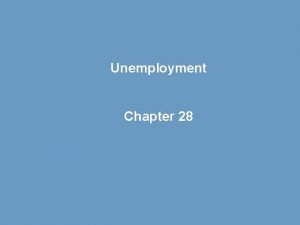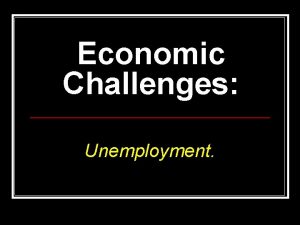Unemployment v Types v Calculating Rates v Implications











- Slides: 11

Unemployment: v Types v Calculating Rates v Implications

TYPES OF UNEMPLOYMEN T • Frictional Unemployment: When people take time to find a job. • Example: When someone is laid off, changes jobs, or need time to find a job after graduating from school.

TYPES OF UNEMPLOYMENT • Structural Unemployment: When workers’ skills do not match what jobs are available for (structure of) the current economy. • Causes of Structural Unemployment: • New Technology • New Resources • Changes in Consumer Demand • Globalization- Shift to foreign markets • Lack of Education

• Seasonal Unemployment: When industries slow or shut down for a season of the year to make seasonal shifts in production schedules and people lose their jobs. TYPES OF UNEMPLOYMEN T • Examples: When people who sell Halloween costumes or Christmas trees are out of a job because the holiday has passed.

TYPES OF UNEMPLOYMENT • Cyclical Unemployment: Unemployment that goes up during times of economic turmoil, and goes down during times of economic prosperity. • Examples: A recession causes people to save more and spend less, because of this companies may slow down production and lay off workers.

THE UNEMPLOYMENT RATE • The rate of unemployment is a great way to measure the health of your economy. • The Unemployment Rate is the percentage of a nation’s labor force that is unemployed. • The Labor Force is NOT every citizen. • The Labor Force is made up of individuals 16 and older who either have a job or are actively seeking for a job. • The Unemployment Rate is adjusted to account for seasonal unemployment so that it is more

CALCULATING THE UNEMPLOYMENT RATE • To find the Unemployment Rate, we use the following equation: • For Example, if there are 7 million unemployed people. And there are 150 million people in the civilian labor force, we have the following rate of Unemployment:

GOAL: FULL EMPLOYMENT • Zero Unemployment is always impossible in a market economy. • But we strive for Full Employment where no cyclical unemployment exists in the economy. • An unemployment rate of about 4 -6 percent is normal during full employment.

ASPECTS OF FULL EMPLOYMENT • Full Employment means everyone who wants a job has a job. • But some of those people may be Underemployed meaning they are working at a job below their skillset. • Example: An individual with a Master’s degree, unable to find work in their field, and settling for a job at Publix.

ASPECTS OF FULL EMPLOYMENT • Additionally, some people give up trying to find work, especially during a long recession. • When people stop looking for jobs and rely on other means to sustain themselves, they are considered a Discouraged Worker. • These people are NOT actively seeking a job and are therefore not included in the Unemployment Rate. • If Underemployed and Discourage Workers were included in the Unemployment Rate, it would be much higher.

WHICH UNEMPLOYMEN T RATE IS THE REAL UNEMPLOYMEN T RATE?
 Calculating unemployment rate
Calculating unemployment rate Pheblitis
Pheblitis How to calculate drip factor
How to calculate drip factor Unit ratio
Unit ratio Ratios and proportions guided notes
Ratios and proportions guided notes Ratios rates and unit rates
Ratios rates and unit rates Ratios rates and unit rates
Ratios rates and unit rates The 4 types of unemployment
The 4 types of unemployment Types of unemployment
Types of unemployment Types of unemployment
Types of unemployment Why are some types of unemployment unavoidable?
Why are some types of unemployment unavoidable? 4 types of unemployment
4 types of unemployment









